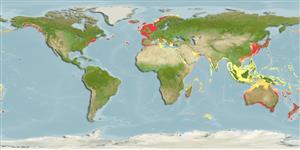Common names from other countries
Classification / Names / Names
Nombres comunes | Sinónimos | Catalog of Fishes (gen., sp.) | ITIS | CoL | WoRMS
Environment: milieu / climate zone / depth range / distribution range
Ecología
Pelágico; rango de profundidad 0 - 250 m (Ref. 1134). Subtropical; 7°C - 30°C (Ref. 1134)
Distribución
Países | Áreas FAO | Ecosistemas | Ocurrencias, apariciones | Introducciones
Atlantic, the Mediterranean and Indo-Pacific. Tropical to temperate.
Length at first maturity / Tamaño / Peso / Age
Maturity: Lm ? range ? - ? cm Max length : 60.0 cm COLD macho / no sexado; (Ref. 1610)
Minimum depth from Ref. 116065. Marine, planktonic; most plentiful below 250 m (Ref. 1134). Filter-feeder. Forms blooms (Ref. 130729).
Life cycle and mating behavior
Madurez | Reproducción | Puesta | Huevos | Fecundidad | Larva
Members of the order Pyrosomatida includes clonal and sexual phases in its life cycle. Life cycle: Eggs develop into lecithotrophic oozooid (cyathozooid) which undergo budding to form four blastozooids. The oozoid degenerates and the colony is formed from the blastozooids.
Kott, P. 2005. (Ref. 1134)
IUCN Red List Status (Ref. 130435)
CITES status (Ref. 108899)
Not Evaluated
Not Evaluated
Human uses
| FishSource |
Herramientas
Más información
Age/Size
Crecimiento
Length-weight
Length-length
Morfología
Larva
Abundancia
Fuentes de Internet
Estimates based on models
Vulnerability
Moderate vulnerability (44 of 100).
Price category
Unknown.
